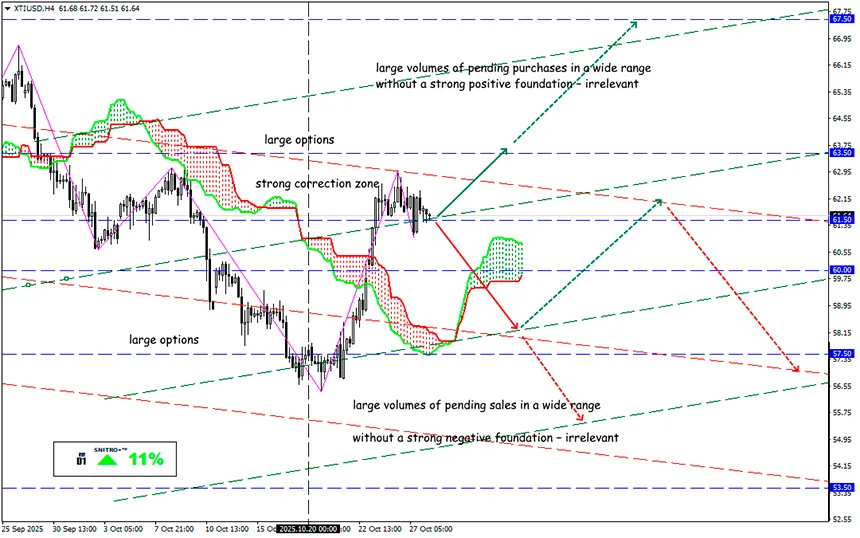The Asian Dragon Is Ready for a Trade War

XTI/USD
Key zone: 60.50 - 62.50
Buy: 63.00 (after a retest of 62.00); target 65.50-67.00; StopLoss 62.30
Sell: 60.00 (on strong negative fundamentals); target 58.50; StopLoss 60.70
The day after tomorrow, they will finally meet — American Donald Trump and Chinese Xi Jinping. The outcome of the talks will likely be superficial victories for both sides. A comprehensive and mutually beneficial agreement remains unrealistic for now, but that doesn’t prevent Trump’s wild tariff hikes from being postponed for a few more months — until new local arrangements are reached.
China began building protection against disruptions in fuel, food, and metal supplies back during Trump’s first term. Since early 2024, when it became clear that Donnie might return to the White House, Beijing has been increasing its reserves of fuel, food, and metals to reduce dependence on external supplies. In the spring, after new tariffs on Chinese goods were introduced, the process accelerated.
For example, at the Dongjiakou oil storage facility — which is never empty — about 10 million additional barrels of oil have been injected since January 2025, bringing the total volume to over 24 million barrels. This makes the country more resilient to external pressure but also creates new risks and dependencies.
Betting on Domestic Production
Despite the growth of the electric vehicle sector, China will continue to consume around 16 million barrels per day, 75% of which are imported. Since 2019, under Xi Jinping’s strategy for developing domestic production, oil output has risen from 3.8 to 4.4 million barrels per day, while gas production has increased 1.5 times. Coal mining is being expanded, and active geological exploration continues for ten metals — from copper to lithium and cobalt.
Building Reserves
China’s oil reserves (based on rough estimates!) total 1.2 billion barrels — three times the size of the US strategic reserve. Moreover, law requires energy companies to maintain their own stockpiles. China continues to import raw materials from Iran, Russia, and Venezuela despite sanctions. Storage facilities are only 58% full, and construction of new ones continues. By the end of 2025, reserves could reach 1.5 billion barrels, equivalent to 150 days of imports. Gas reserves are smaller — 30–40 billion cubic meters, about 10% of annual demand. No official data exist for metals, but according to Panmure Liberum estimates, over the past 20 months China has stockpiled 20% of annual copper demand, 50% of zinc, and more than 100% of nickel.
Diversifying Supply Sources
When stockpiling is impossible, Beijing seeks new sources. China is expanding gas imports from Russia, Qatar, and Malaysia. Chinese corporations are actively acquiring foreign assets — since 2024, they have purchased nine copper projects, built a coal railway from Mongolia, and are negotiating to buy part of Chile’s power grid. Special attention is paid to agricultural imports: the share of American soybeans (about 25% of imports) has sharply declined after a 20% tariff was imposed. Now Brazilian farmers are expanding soybean acreage while American ones cut back. China has become a “swing supplier” of gas, reselling LNG during price surges. But opaque reserves make the market less predictable, while gray import schemes support the shadow fleet and unofficial financing.
The “cost” of such a policy is growing. If oil prices fall another $10 per barrel, overpayments will amount to billions of yuan per month. Metallurgists are already recording losses, copper refining is moving into the red, and Brazil sells soybeans with a high premium.
Of course, the accumulation strategy makes China more confident but does not eliminate risks: reserves provide time for maneuver but do not guarantee survival. Even if the leaders fail to reach an agreement on Thursday, Beijing is already far better prepared for a full-scale trade war than the United States. Only Trump doesn’t know it yet.
So we act wisely and avoid unnecessary risks.
Profits to y’all!

















